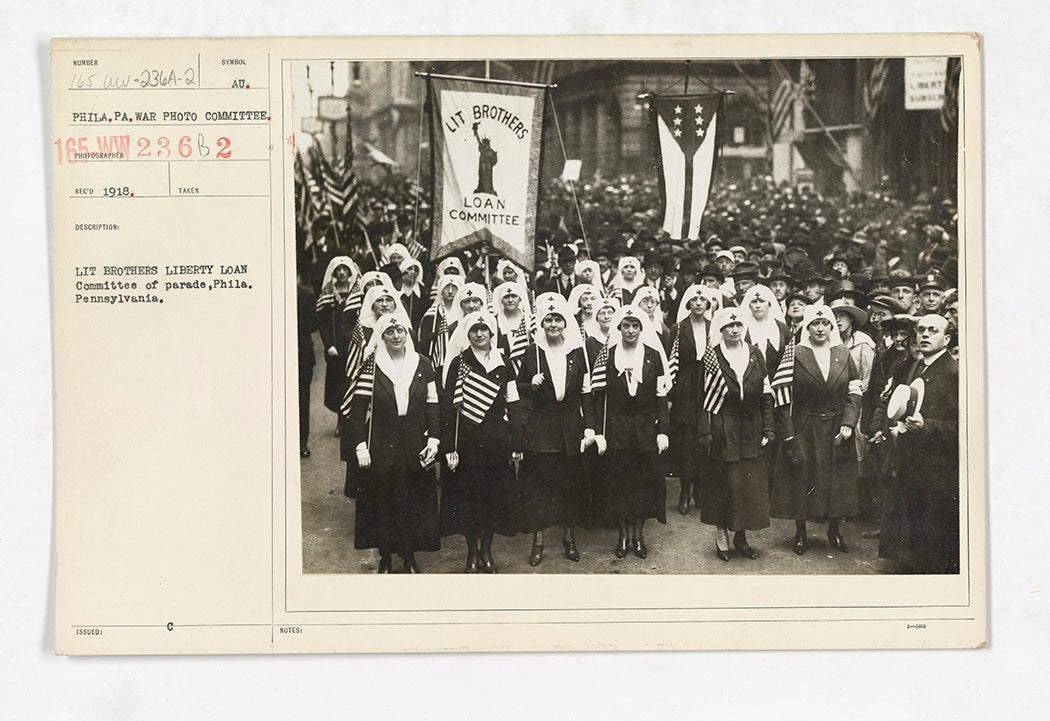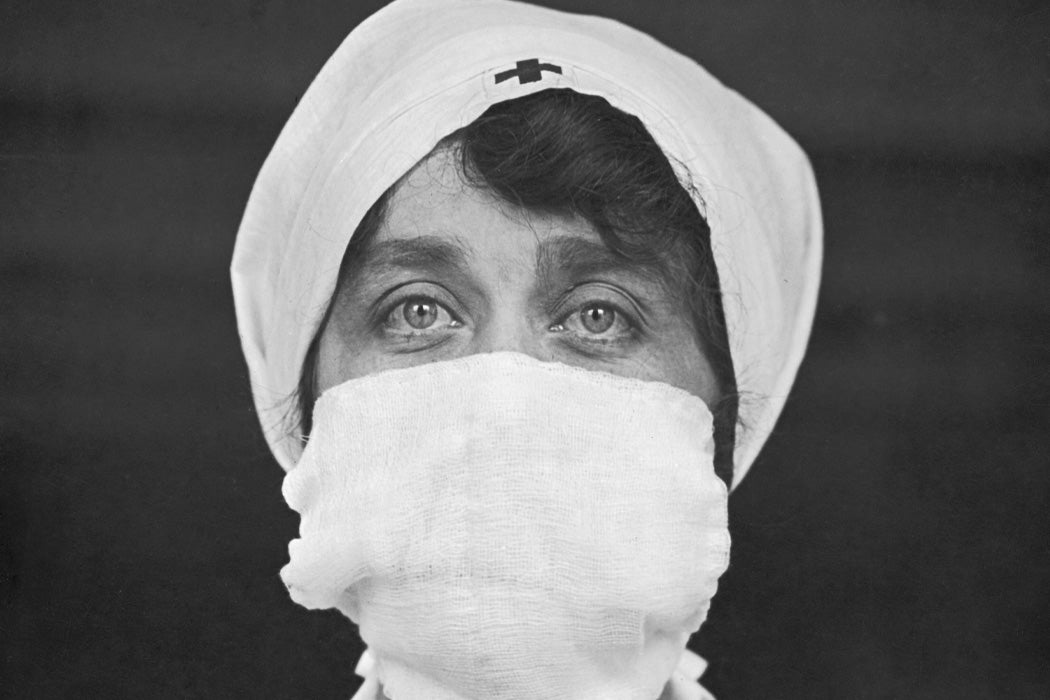The influenza pandemic of 1918-19 killed between 50 and 100 million people around the world, more than died in the battles of World War I. In the United States, the hardest-hit city was Philadelphia, where the spread of the disease was spurred by what was meant to be a joyous event: a parade.
Writing in Pennsylvania History: A Journal of Mid-Atlantic Studies, the historian Thomas Wirth explains what happened: “On September 28, despite the increased infiltration of the disease among the civilian population, a rally for the Fourth Liberty Loan Drive proceeded with minimal debate about the repercussions for public health.” The head of Philadelphia’s Naval Hospital told the Public Ledger in the days before the parade: “There is no cause for further alarm. We believe we have it well in hand.” So, the parade went forward. “In the streets of downtown Philadelphia 200,000 people gathered to celebrate an impending allied victory in World War I. Within a week of the rally an estimated 45,000 Philadelphians were afflicted with influenza.”
While frequently called Spanish flu, the disease did not originate in Spain. Rather, the country’s wartime neutrality contributed to higher reports of its escalation in its newspapers. Exactly where and when it started in 1918 is still under speculation. But by the fall of that year, it had arrived in Philadelphia.
“At first, Philadelphia’s epidemic did not differ from that in other major American cities,” the historian James Higgins writes in Pennsylvania Legacies. “Yet by the first week of October, roughly five weeks into the outbreak, Philadelphia’s mortality rate accelerated in a climb unmatched by any city in the nation—perhaps by any major city in the world.” And that spike is attributed to the patriotic event, one of several Liberty Loan rallies organized in Philadelphia to raise money for the war. This time it was joined by a baneful guest: “The virus, an invisible presence at the parade, had enjoyed an unprecedented opportunity to spread throughout the city and in the coming days announced its presence in a skyrocketing wave of sickness and death.”
Soon hospitals were at capacity, as were the morgues and cemeteries. In a study published in 2009 in the Proceedings of the National Academy of Sciences on the incidence curves of the 1918 epidemic in Philadelphia, researchers note that, 72 hours following the parade, all the beds in the city’s 31 hospitals were filled and by “the evening of October 3, the closure of schools, churches, and places of public amusement was adopted by the Philadelphia city council.”
In six weeks, 12,000 were dead. The smell of bodies left to rot in homes while they waited to be removed permeated the streets. The spread of the virus was exacerbated by existing conditions in the city: a booming population drawn by the wartime industries, a density of housing, and a lack of sanitation services and safe drinking water in these working-class neighborhoods.

Adding to the crisis was a shortage of medical staff, as many were abroad in the war effort. As more and more people got sick, the operation of the city ground to a halt. “Thousands of city workers were out sick, including street car drivers, telephone receptionists, shopkeepers, and garbage collectors,” writes the nursing historian Arlene W. Keeling in Public Health Reports. “In the already overcrowded tenement districts, conditions simply got worse. When the nurses also became sick, the situation became critical.”
The city’s public health director Wilmer Krusen declared: “If you would ask me the three things Philadelphia most needs to conquer the epidemic, I would tell you ‘Nurses, more nurses, and yet more nurses.'” With this dearth of nurses, nuns from the Roman Catholic archdiocese stepped in to offer care. Importantly, they didn’t just visit hospitals, they went into neighborhoods long marginalized by the city where many of the sick—especially those unable to pay for medical services, or African Americans who were not permitted in the segregated hospitals—were dying.
“The importance of the Sisters’ work in the African American communities cannot be overstated during this time of stark racial segregation,” the historian Christina M. Stetler writes in Pennsylvania History. “The Sisters were going into the homes of African Americans to provide much-needed care, for African American patients and families had few other avenues of assistance.”
Students from the Catholic seminaries helped bury the mounting dead. In June 1919, Rev. Thomas C. Brennan recalled the situation at the Holy Cross Cemetery, as recorded in the Records of the American Catholic Historical Society of Philadelphia:
Who can describe the scenes that met the eye during these harrowing days? Animus meminisse horret luctuque refugit. We must be content with little intimations. Everywhere, in every direction, fresh graves swept away from the gaze of the onlooker, causing the well-kept cemetery to resemble a shell-torn field of battle. A constant procession of hearses pressed at the gates—hearses and substitutes for hearses: newspaper wagons, trucks, coal-carts, ash-wagons.
Many of those buried were interred without headstones in long trenches. The deaths must have felt like they would never end. But by November, the virulence of the disease eased. Although there were cases into 1919, the frequency of infection slowed. Grass grew over the hastily dug graves in Holy Cross. And as people got better, and the country was caught up in the euphoria of World War I’s end, the brief turmoil of the epidemic began to fade from the collective memory.
Even in March 1919, only months after the outbreak, Rev. Francis E. Tourscher felt compelled to begin a compilation of oral histories from the Catholic nuns of Philadelphia, with an acknowledgement of the amnesia of epidemics:
Facts unrecorded are quickly lost in the new interests of changing time. […] We have little left now, beyond mere material statistics, and vague impressions drawn from “paper accounts” of the epidemic of cholera which visited Philadelphia in 1832. We know probably as much of the “Black Death” of 1348 in Europe or of the “Sweating Sickness” of 1529 in England as we do of the “Yellow Fever” which raged in our cities of the South, and threatened the North, in 1849 and again in 1854.
The stories from these witnesses are now invaluable in offering a ground-level view of the Philadelphia epidemic. They relate how the nuns worked across class and racial lines. There are scenes of whole families dying one by one. The nuns described cleaning houses, visiting hospitals, carrying clean water to those who were weak, and staying with the dying in their final moments. Tourscher’s account, concluded in the September 1919 issue of the Records of the American Catholic Historical Society of Philadelphia, includes sisters from St. Anne’s who find “a mother and two children [who] had been lying fully clothed for four days with no one to go near them.” In another “‘well-to-do family’ the Sisters [of St. Columba’s] found five children, all lying ill, in different parts of the house, and the mother in bed absolutely unconscious.” The sisters did what they could— changing bed linens, bringing food, and sometimes ultimately sending for a doctor and a priest.
Weekly Newsletter
No public memorial or monument in Philadelphia commemorates the actions of those who cared for the sick or those who died. On September 28, 2019—exactly 101 years since the deadly 1918 parade—the artist group Blast Theory, in collaboration with the Mütter Museum of the College of Physicians of Philadelphia led a procession to commemorate the dead and honor those who cared for them. Participants carried the names of a victim as the litany of the dead was sung out.
A film of this contemporary parade is part of the new Spit Spreads Death: The Influenza Pandemic of 1918-19 in Philadelphia exhibition at the Mütter Museum. Through artifacts, personal stories, death certificates, and recent research, it recalls this often forgotten era of history. It also looks ahead to how the lessons of the past can prepare for the future, asking: are we more prepared for an epidemic today, and who will be there to care?







